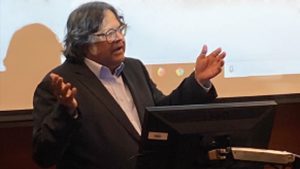 Gary A. Anderson |
In business and academic circles, few would dispute that education offers added value to individuals and to the communities where they live and work.
But how do you put a price on that value?
Numerous published studies address how—and how much—education contributes to income. Indeed, vast theoretical and empirical research at both the micro and macro levels zeroes in on the notion of investment in education to build human capital.
Now, two colleagues in the College of Business’s Department of Finance have taken a fresh look at this equation in an article titled “Building Human Capital through Education,” published recently in the Journal of Legal Economics.
 James D. Keys |
Gary A. Anderson, associate professor, and James. D. Keys (MSF ’87, MBA ’77), instructor, developed an alternative model to the present-value assessment of the differential in after-tax earnings and fringe benefits between a college education and a high school one.
Using data from sources such as the Bureau of Labor Statistics within the U.S. Department of Labor, their new model evaluates the present value of differential after-earnings and fringe benefits as predicated on the mean year-round earnings in 2002 for both sexes and all races. The model also measures the present value contribution to federal income tax revenue associated with the increased earnings among individuals holding a college degree compared to those with a high school diploma.
“Our approach differs from others in that we looked at average earnings and we used the actual age earnings profiles for college and high school graduates,” Anderson said. “We also used the actual marginal tax rate earnings—or the differential earnings—something not previously done in this type of research.”
In addition, their research integrates data related to different work/life statistics associated with higher degrees of education. Their hypothesis was that those who achieve higher education likely remain more active in the workforce longer.
“A key underlying premise of our research is that it is important to understand how the value of education is measured.”
—James. D. Keys, instructor, Department of Finance
“A key underlying premise of our research is that it is important to understand how the value of education is measured,” Keys said. “This understanding, in turn, provides a better framework for seeing how future opportunities may marginally affect human capital.”
Why it pays to go to college (and look who benefits).
The study calculated that the present value of future after-tax earnings plus fringe benefits for the average high school graduate comes in at almost $1 million. For the average college graduate, the value of earnings plus benefits—less the cost of tuition and the loss of four years of earnings while attending college—doubles to approximately $2 million.
The present value of the differential in after-tax earnings with fringe benefits adds up to $927.000, giving further credence to the old adage that education pays.
And not only college graduates reap the rewards of higher education. While individuals benefit more than $900,000 in present value, the Internal Revenue Service (IRS) benefits by more than $100,000 in taxes paid.
Research carries a message for students, business, and government.
In his classes, Anderson presents the concept that human capital constitutes the largest asset that most high school and college graduates possess.
“I hope to impress upon my students the idea that they should view the decisions they make over their careers as contributions to this asset,” he said. “Students often find this perspective difficult to grasp because the payoffs are in the future—with the largest contributions occurring in the quite distant future.”
Recognizing that remoteness, the study calculates the benefits in yet another way: If one breaks down the present value of the difference in earnings on an hourly equivalent rate of pay—and assuming a student invests forty hours per week in attending and preparing for undergraduate classes over a nine-month period for four years—the current rate of after-tax pay comes to approximately $161 per hour, a compelling figure.
Anderson believes the research he and Keys conducted carries another message to business and legislators funding higher education.
“It simply makes sense at the basic dollars-and-cents level to fund student education.”
—Gary A. Anderson, associate professor, Department of Finance
“Yes, our students and our economy benefit from education—and it makes us more competitive globally,” he said. “But as our research indicates, it simply makes sense at the basic dollars-and-cents level to fund student education.”




